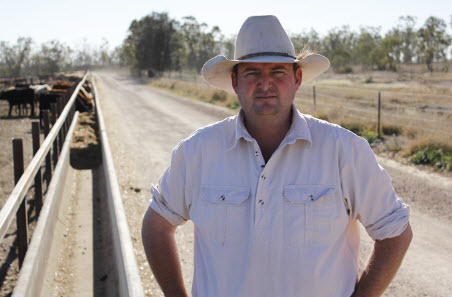Reardons win top MSA grainfed honours
Robert and Jenny Reardon are successfully integrating and expanding cattle finishing in an irrigated cotton, dryland cropping and grazing operation that spans 25,000 hectares on the Queensland-New South Wales border.

The pair set up Reardon Operations Feedlot in the 1990s on their Worral Creek property, near Talwood, and won the 2017 MSA Excellence in Eating Quality Most Outstanding Beef Producer – Grainfed award for Queensland/Northern Territory presented at Gympie last night. (Click here for more details about the Queensland MSA Awards)
The Excellence in Eating Quality Awards for Grainfed producers recognises feedlots that have produced cattle eligible for Australian Grainfed Beef Standards and have high compliance rates to the MSA minimum requirements and consistently high eating quality performance – as determined by the MSA Index – for cattle consigned during 2015-16 and 2016-17 in each State and Territory.
Reardon Operations General Manager Tristram Hertslet said the keys to consistently achieving good MSA results were using quality feed, good water and excellent stock handlers to finish cattle with an even temperament.
He said the 1000-head capacity feedlot sourced weaners from the Reardon family’s property aggregation spread across the Goondiwindi, Mungindi and Moree districts.
“On average, the feedlot has been turning-off about 300 head of weaners per year,” Mr Hertslet said.
“But, as the cattle enterprise has been expanded, production is increasing to an expected 600 head turn-off from 2017 onwards.”
Mr Hertslet said Reardon Operations Feedlot had been MSA-registered since starting operations.
“We joined MSA to receive feedback about the performance and eating quality of our cattle at processing, particularly for traits that are important to consumers, and to monitor any changes in those traits,” Mr Hertslet said.
“This feedback underpins improvements we are making back on-farm, from the paddock, through the feedlot and during preparation for transport.
“In particular, we look at our MSA pH scores to determine if animals are stressed; fat scores to meet particular markets; and the MSA Index value that indicates potential eating quality from all measurements collected.”
The MSA Index is designed to provide meaningful producer feedback on eating quality performance which can be used for benchmarking. It is independent of any processing inputs and reflects attributes influenced by genetics, pre-slaughter management and the environment.
Mr Hertslet said cattle consignments coming out of the Reardon Operations Feedlot typically had an MSA Index range of between 55 and 63; achieved 100% to MSA requirements including pH scores typically between 5.4-5.59; and fat scores met the targets for supplying direct to Woolworths and Coles supermarkets and Teys Australia.
He said the feedlot finished weaners comprised a mix of Angus, Santa Gertrudis and Simmental-cross breeds.
“We graze the breeding stock on the Worral Creek property, which has predominantly been set up for irrigated cotton and dryland winter and summer cropping,” he said.
“If the season is good and weaner weight gain is sufficient, we will leave them in the paddock running on native grasses or improved pastures – mostly those sown with an oat cover crop.
“If conditions deteriorate and become dry, we shift them into the feedlot after a period of introduction to grain and hay in self-feeders in the paddock.
“Our target entry weight is about 300 kilograms and cattle typically stay on feed for 70 to 120 days, depending on the final market and when cattle reach their optimum point.”
Mr Hertslet said the aim was a totally smooth transition from quality pastures to feedlot finishing to preparing for transport to processor - getting the cattle used to a different ration and to staff being around.
“Our goal is to keep the weaners’ stress levels low the whole way through the supply chain to produce quality and consistent beef that meets consumer expectations,” he said.
Mr Hertslet said having a multi-faceted business meant Reardon Operations could produce and use its own silage, grain (mostly gradings) and cotton seed in the feedlot starter, intermediate and finisher rations.
“We are also value-adding to these by-products for the overall business by converting them to kilograms of beef,” he said.
Mr Hertslet said in recent years, more emphasis had been put on using superior genetics for key breeding and eating quality traits and the numbers of cattle now going through the feedlot would be among the highest they had ever been.
He said consideration was being given to converting existing dryland production country on the Worral Creek property to permanent pasture to expand the cattle enterprise and, in turn, increase feedlot production in coming years.
For more information about the MSA system, visit: www.mla.com.au/msa
To look at your own carcase feedback and use the MSA Index calculator, visit: www.mymsa.com.au



